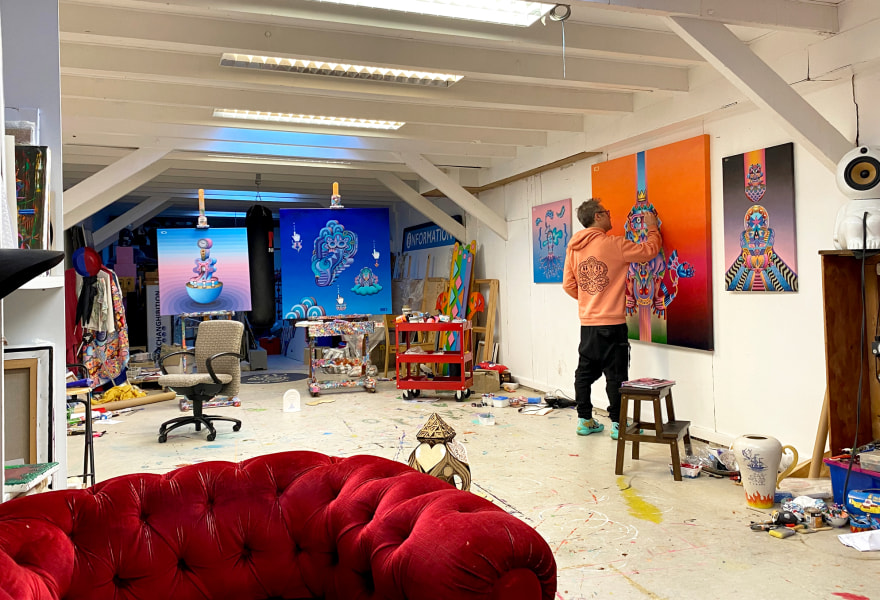22 january 2024, Wouter van den Eijkel
The Studio of… Dadara
Next Saturday, Ctrl Alt Delirium, the new solo exhibition by Dadara, will open. Daniel Rozenberg, known as Dadara in his daily life, rose to prominence in the early '90s with his flyer designs for raves and is famous for his numerous installations at the Burning Man Event. His first project, 'Fools Ark,' in 2002 marked the beginning of a long series. For over 30 years, he has been creating work that is both critical and playful. Dadara observes, looks ahead, investigates, reflects, and creates. In "Here for the Art," the book presented during the opening, he succinctly summarizes his approach: "My two favorite media are acrylic paint and mindfuck.
Here for the Art reflects on Dadara's work over the past five years, including many guerrilla projects executed in public spaces during the lockdowns. Notable examples are The Artist is not Present, in which he placed a table and two chairs on the Museumplein, and I am Dream, an alternative version of the immensely successful city marketing slogan "I Amsterdam." In addition to a section dedicated to Covid-19 interventions, Ctrl Alt Delirium features around ten new works. The exhibition will be on display until Saturday 24 February.
Where is your studio and how would you describe it?
My studio is located in De Pijp in Amsterdam just outside the city centre. It is a 30-meter-long annex behind my house.
Is such a central location a prerequisite for you or would you be just as comfortable working outside the city?
I have always worked in the heart of the city. To me, art, music, film, etc., have been as essential as air throughout my life. It is the oxygen of my existence and a city is the place where all these things are readily available, with the additional advantage that I live a five-minute bike ride from my favourite cinemas, Kriterion and Rialto. On the other hand, I love that my studio is behind my house without any neighbours, allowing me to emotionally isolate myself from the inhabited world for days on end.
You gained fame in the '90s as a designer of rave flyers. What kind of music is playing in the background when you work?
My work still occasionally has a connection to music (last year, for example, I created artwork for the Portuguese Boom Festival), although much less than in the early '90s. I always have music on when I paint and it can be quite diverse – Boards of Canada, Leonard Cohen, Philip Glass, Moderat, Lil Peep, Marilyn Manson, Mac Miller – but always one album or one DJ mix on repeat.

Dadara, Book Here for the Art
Congratulations on the new book Here for the Art! In the foreword, your gallery owners/publishers state that your recent work is strongly connected to Amsterdam. Does this apply in general as well?
Hard to say because I also work internationally. I spent a long time working on major projects at Burning Man in the United States, for instance, and in recent years, have worked extensively in Spain and Portugal, Amsterdam has been my base for over 30 years. I think the fact that I am away so much contributes to my continued appreciation for Amsterdam. The new book also features numerous collaborations with other Amsterdam-based artists.
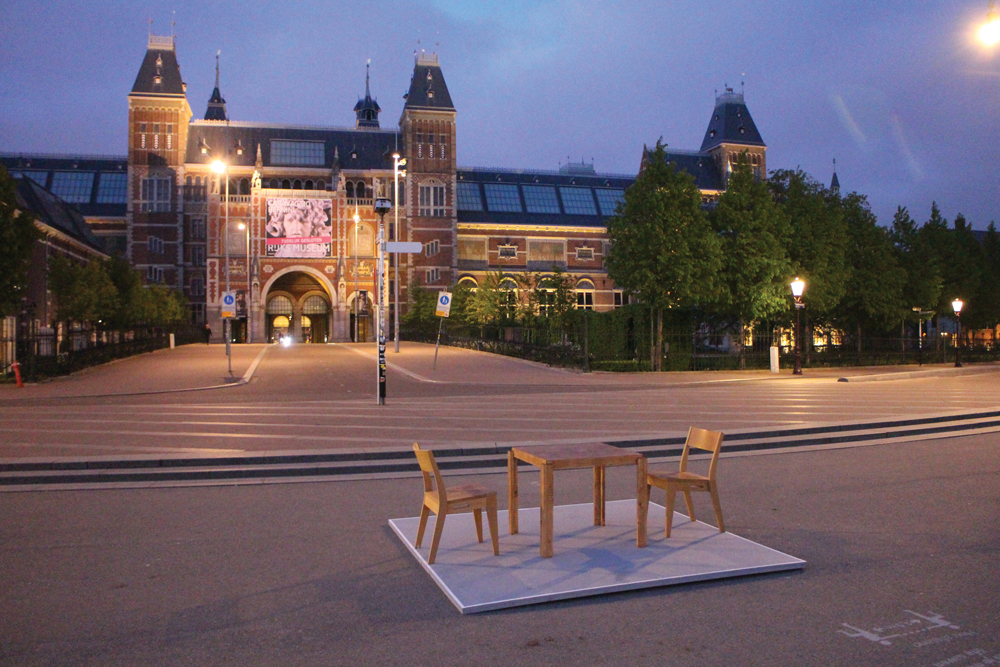
Dadara, The Artist is not Present
Several works in the book were created during the pandemic lockdowns. One of them is The Artist is not Present in which you placed a table with two chairs on the completely deserted Museumplein. What did you want to convey with this?
It was inspired by Marina Abramovic's work The Artist is Present at MoMA, in which thousands of visitors could sit across from her. But by removing her and naming it The Artist is not Present, I hoped to make visible that without artists, we are left with only a functional, material reality. This seemed particularly relevant during the pandemic, when art was considered non-essential. The fact that it was subsequently removed by municipal enforcement officers (BOAs) and I turned it into a sculpture further strengthened that message.

Dadara, I Am Dream
During the same period, you also created I am Dream on the Museumplein – a playful take on Martin Luther King's speech. It involved placing a fence around the marketing slogan 'I Amsterdam' near the Rijksmuseum, featuring a photoshopped version of the letters 'I Amsterdam' rearranged into 'I am Dream.' Unlike a table and two chairs, you don't just casually set up a fence. How did you accomplish this and why did you choose to do so specifically at the Rijksmuseum?
I noticed that all the free cultural spaces were gradually disappearing from Amsterdam, culminating in the eviction of the ADM, which gave me the idea for this project. To me, the 'I Amsterdam' letters symbolised a city marketing campaign that clashed with the alternative culture that Amsterdam also had to offer. In September 2018, a decision was suddenly made to remove the letters and I wanted to proceed with my plan, so I expedited the process. We planned the action well so that over 60 meters of fencing and banners could be quickly placed around the letters with a large team in the early morning. The fact that everyone wore orange fluorescent vests also helped to achieve it discreetly.
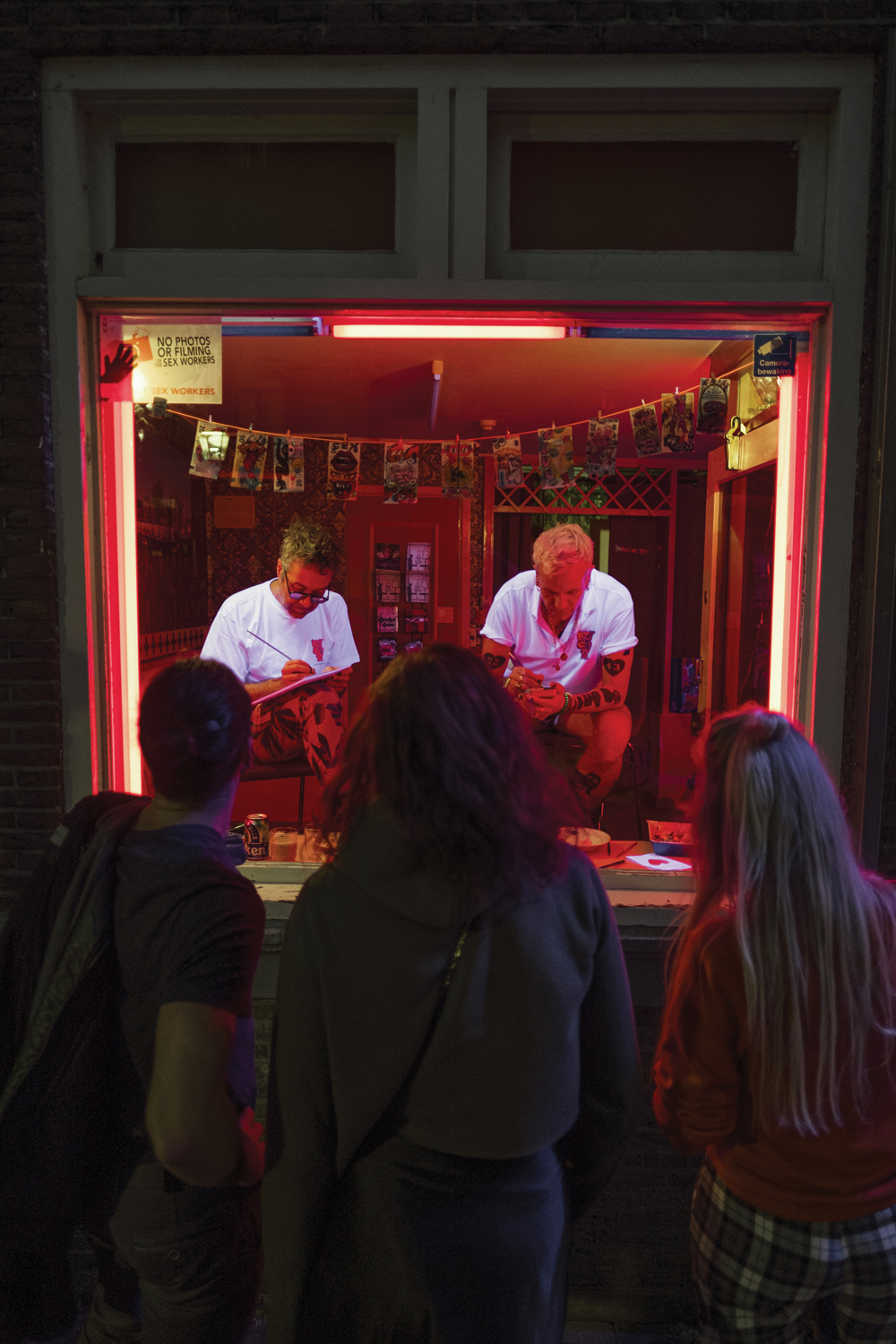
Dadara, Transactions Amoureuses
Another theme in your work is money and people's tendency to express everything in monetary value. During the lockdown, you and Bas Kosters painted banknotes in a peep show room in the Red Light District during the Transactions Amoureuses project – yours was the only peep show room with the lights on. Why did you choose to paint on banknotes in a peep show room?
The relationship between art and money has always been complicated. On the one hand, you need money to survive in our society, but as an artist, you don't want to sell your soul for money, or more literally, ‘prostitute yourself for money’. So, a peep show room seemed like a symbolically fitting place. Apart from that, I simply find the picture of Bas and me in the red window visually attractive. It's quite extraordinary that during the lockdown, I could gain access to unique locations for many projects – the city truly became my playground.
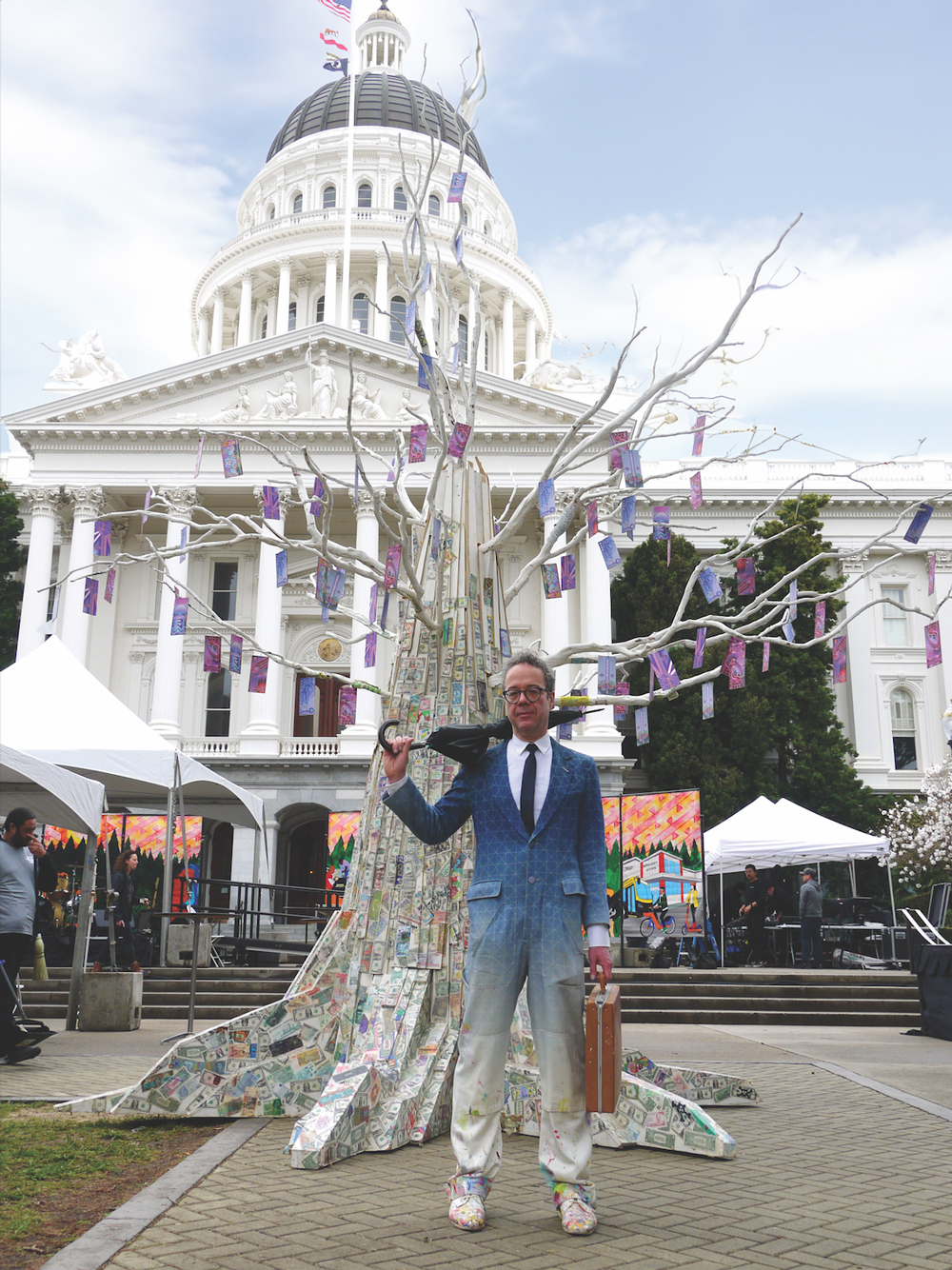
Dadara, Transformoney Tree
One of the projects featured in the book is the Transformoney Tree, a tree where people can hang painted banknotes, giving the bills more than just monetary value. You started the project as Exchanghibition Bank during the financial crisis from 2008 to 2013 when governments were willing to bail out banks, but heavily cut funding for the arts and culture sector. With the election results last November, we are probably on the verge of another round of budget cuts. Do you think it's time for a Transformoney Tree in the Netherlands, perhaps on the Frederiksplein?
Value seems to have become synonymous with financial worth in our society, which is why I think many don't recognise the true value of art. After the Transformoney Tree stood at Burning Man, Woodstock and in front of the California State Capitol, I would love to have the opportunity to bring it to the Netherlands. And I just so happen to live near the Dutch Bank on Frederiksplein... So, if anyone reading this has connections there or any other good idea for a location in the Netherlands, get in touch with me!

Dadara, Navigating realms, 2024
What are you currently working on?
At the moment, I’m putting the finishing touches on the paintings for my new CTRL ALT DELIRIUM exhibition, which will be opening soon at KochxBos Gallery. In the current picture, my studio is still full, but hopefully will soon be much emptier and ready for new ideas.
Opening Ctrl Alt Delirium Saterdag 27 January 5PM - 8PM
6PM Book presentation ‘Here for the Art’
During the opening, we will present Dadara's latest book 'Here for the Art.' The first copy will be handed over to Merlijn Twaalfhoven around 6:00 PM, who wrote the essay 'To drown, surf, or dive in waves of reality.' In addition, Dadara will provide an introduction to his latest work and engage in a book signing.
The exhibition is on display until Saturday, February 24th.
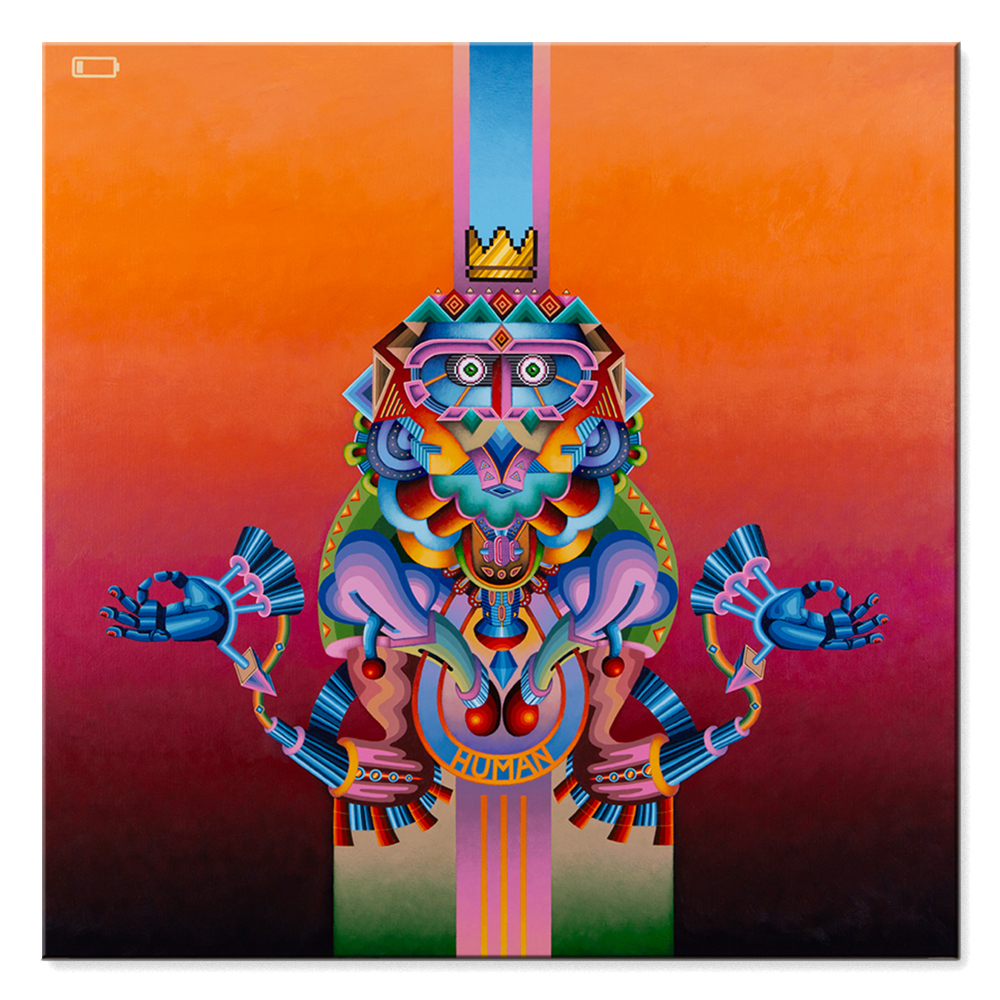
Dadara, Ctrl Alt Delirium
